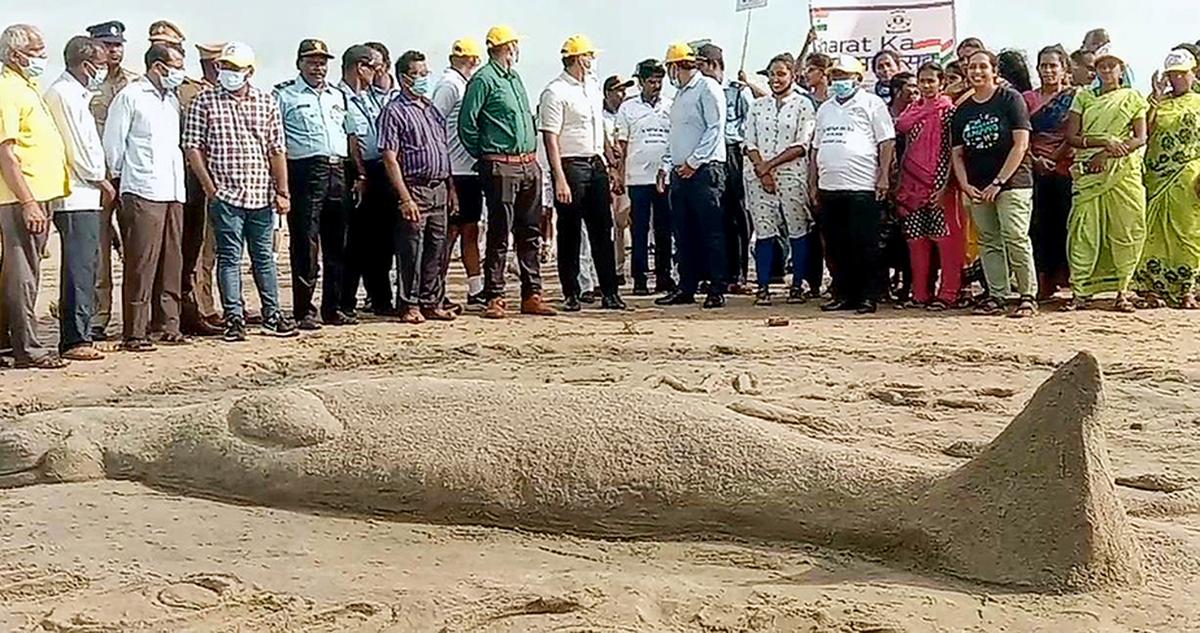Farmers of the sea: India’s dugongs must stay a conservation priority


A dugong sand sculpture at Danushkodi beach to mark World Environment Day in June 2022.
Waving meadows of emerald grasses part as a portly shape drifts through the shallow waters. Like a blimp led astray, the creature uses its front flippers to paddle gently as it nibbles on the seagrass that makes its home. Silt stirs from the shallow seafloor, coral reefs reveal themselves in a riot of colours, with shoals of fish scurrying out of the way, and an entire ecosystem comes into view.
Meet the dugong — the farmer of the sea.
May 28 is celebrated every year as World Dugong Day. Dugongs (Dugong dugon) are the only herbivorous mammals found in India’s marine ecosystems. This gentle giant — known as the sea cow but resembling a cross between a seal and a whale — is distributed through the Indo-Pacific region. Due to their dependence on seagrass beds for habitat and food, dugongs are restricted to shallow waters, where they spend the day feeding on seagrasses of the genera Cymodocea, Halophila, Thalassia, and Halodule. They root at the base of shorter seagrass species, eating rhizomes, stems, and leaves, thus clouding the shallow waters. This is how they earned their epitaph. (Also see the addendum.)
Seagrass is low in nutrients, so dugongs feed extensively throughout the day to meet their daily requirements. They can consume 20-30 tonnes of seagrass per day, crushing leaves and stems against their horned teeth before swallowing. Unlike other marine mammals, the way they eat allows dugongs to digest cellulose, although the process wears down their teeth quickly. For this reason, dugongs rapidly regrow teeth in multiple iterations throughout their lives.
Unlike manatees, their close relatives, dugongs are more strictly marine, preferring waters a few metres deep. They are found along the Indian coastline, primarily inhabiting warm waters around the Andaman and Nicobar Islands, the Gulf of Mannar, Palk Bay, and the Gulf of Kutch. The dugong is a long-lived species, able to live up to 70 years.
Dugongs are also generally solitary or found in small mother-calf pairs. Researchers have occasionally observed small groups, but large herds — as are common in Australian waters — are rare in India.
Individuals reach reproductive maturity after only nine or ten years and can give birth at intervals of around three to five years. Due to its slow reproductive cycle, extended time to maturity, and infrequent calving, a dugong population’s maximum potential growth rate is estimated to be just about 5% per year.
Threatened waters
But for their unassuming nature, dugongs are listed as being ‘vulnerable’ on the IUCN Red List for Threatened Species. The threats they face worldwide include rapidly declining populations and the ongoing degradation of their seagrass habitats. In India, they are classified as ‘regionally endangered’. Once widespread in Indian waters, their numbers have dwindled to an estimated 200 individuals, with both their population size and geographic range continuing to decline.
According to research by independent marine researcher Prachi Hatkar, coastal areas around India are increasingly under pressure from expanding residential, recreational, and agricultural activities. As more people stake claim to these spaces, the risk of pollution rises. Pollution can also affect them directly, with studies showing the accumulation of mercury and organochlorine compounds in their muscle tissues.
Because dugongs reproduce slowly and require vast, undisturbed seagrass meadows to thrive, their populations are highly vulnerable to human disturbances. Seagrass meadows, their primary habitats, are being lost at an alarming rate. Primary threats stem from changing fishing methods, which threaten the meadows. Fishers once relied on non-mechanised boats to fish in shallow waters, including seagrass habitats. But with the advent of modern fishing technologies, these traditional boats have steadily given way to mechanised ones.
The construction of ports, dredging, and land reclamation for industries and tourism have also wreaked havoc on these delicate ecosystems, and pollution from agricultural runoff, sewage, and industrial effluents have degraded water quality, affecting seagrass health.
The ever-present threat of climate change, perceptible in rising sea temperatures, ocean acidification, and extreme weather events like cyclones, also affects seagrass ecosystems, reducing the availability of food as well as safe breeding habitats for dugongs.
Another major threat to dugong populations in Indian waters is accidental entanglement in fishing gear, especially gillnets and trawl nets. Dugongs are air-breathing mammals that must surface regularly. But once entangled, they often drown before fishers can release them. Many of these deaths go unreported, further complicating conservation efforts.
Increased human movement and activity in dugong habitats and more boat traffic in the Gulf of Mannar, Palk Bay, and the Gulf of Kachchh — all directly threaten the species. Dugongs also often rest near the surface, making them vulnerable to collisions with fast-moving boats, leading to injuries or fatalities.
Yet another threat is illegal hunting. While dugongs are a Schedule I species in India, enjoying the highest level of protection granted by law, poaching still occurs, especially in the remote areas of the Andaman and Nicobar Islands.
Way to the future
Unlike manatees, dugongs are shy creatures, preferring to avoid interacting with humans when possible. This creates a general lack of awareness about the species, even among coastal and fishing communities, as well as less attention from the larger conservation community. India has been party to the Convention on the Conservation of Migratory Species of Wild Animals since 1983 and has also been a signatory to the Convention’s Memorandum of Understanding on Dugong Conservation and Habitat Management across their range since 2008.
In 2022, the Government of India officially announced the creation of the country’s first dugong conservation reserve, spanning 448.3 sq. km in the coastal waters of Palk Bay, Tamil Nadu. Recent studies have indicated that this bay is the last stronghold for these gentle herbivores in Indian waters, and the proposed reserve area has around 122.5 sq. km of intact seagrass beds, ensuring habitat and food for the dugong population.
This move, to protect the species at a national level, stems from long-term monitoring and research by the OMCAR Foundation (an NGO), the Wildlife Institute of India, and the Tamil Nadu Forest Department: they have been working to improve dugong conservation and seagrass restoration for more than a decade. Their efforts can go a long way in ensuring the survival of dugongs and their delicate lives.
“Dugongs are gentle giants and act as gardeners of the sea, quietly shaping our oceans by nurturing seagrass meadows,” Ms. Hatkar said. “But their survival now depends on ours — on how urgently we act to protect their fading habitats from pollution, coastal development, and neglect.”
Helping dugong conservation
An important step people can take is to protect and restore seagrass habitats. To do so, we need rigorous mapping and monitoring of existing seagrass meadows to identify more priority conservation areas, much like the Gulf of Mannar Biosphere Reserve. Activities that damage seagrass need to be restricted and community-led seagrass stewardship, including involving local fishers to monitor and restore seagrass, can go a long way in maintaining the dugongs’ habitat. Regulating harmful fishing practices, such as banning gill nets and bottom trawling, in known dugong habitats will also help prevent accidental entanglement.
We also need to promote non-destructive, sustainable fishing techniques that fisherfolk have used in the past. Alternative livelihood options such as dugong-friendly ecotourism using local youth as eco-guides can fulfil the dual role of monitoring dugong populations while raising awareness of their habitats and behaviour, all while empowering local communities.
Increasing awareness and community involvement have always been important aspects of dugong conservation. Many conservation practitioners are conducting awareness campaigns in coastal villages about the ecological importance of dugongs, and many local communities and fishers are trained to report dugong sightings or strandings, facilitating rescue operations when needed.
Another important facet is strengthening research. Researchers need more support, both financial and institutional, for long-term studies of dugong populations, behaviours, genetics, and threats. Developing citizen science programmes and using the traditional ecological knowledge of local communities will add another dimension to existing research. Additionally, advances in tagging and drone technology can be mobilised to track dugong movements and identify critical habitats.
Addendum: why seagrass matters
Seagrass is an underwater flowering plant, not to be confused with seaweed. Classified as wetland ecosystems, seagrass meadows stabilise the seafloor, support fisheries, capture carbon, and shelter marine life. Healthy seagrass is essential for dugongs and marine life such as turtles and fish. A 2022 study by the National Centre for Sustainable Coastal Management documented 516.59 sq. km of seagrass habitat in India. This translates to a carbon dioxide sequestration potential of up to 434.9 tonnes per sq. km each year.
India’s most extensive seagrass meadows occur along the Gulf of Mannar and Palk Bay, off the coast of Tamil Nadu, and together support more than 13 species of seagrass — the highest diversity in the Indian Ocean. The Andaman and Nicobar Islands also support rich seagrass beds and associated biodiversity. While seagrass is present in the shallow reefs of the Lakshadweep Islands and along the coast of Kachchh, they are patchy despite being ecologically significant. In Kachchh in particular, port activities and pollution threaten these coastal wetlands. The coast of Andhra Pradesh and Odisha also supports minor seagrass beds along estuaries, but these habitats are not extensive or suitable for dugong populations today.
Priya Ranganathan is a doctoral student and researcher at the Ashoka Trust for Research in Ecology and the Environment (ATREE), Bengaluru.
Published – May 28, 2025 05:30 am IST















